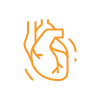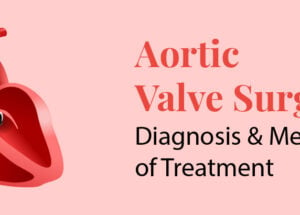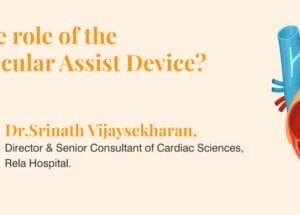What is the function of the heart
May 30, 2022

The structure of a human heart
The heart is a muscular organ in the chest, right behind and to the left of the breastbone. It is mostly the size of a closed fist in measurement. The main function of the heart is to pump blood to all parts of the body through the network of blood vessels called the arteries and veins. These together are known as the cardiovascular system.
The heart is made up of four chambers. While the upper two chambers are called the atria, the lower ones are called the ventricles. The right heart is a combination of the right atrium and right ventricle, and the left heart comprises the left atrium and ventricle. The various other chambers of the heart are separated by a partition each of them is called a septum.
- The right atrium collects deoxygenated blood from the body and transports it to the right ventricle.
- The right ventricle receives blood from the right atrium and pumps it to the lungs to oxygenate it.
- The left atrium transports oxygenated blood from the lungs to the left ventricle.
- The left ventricle is the heart’s most powerful chamber. It distributes oxygen-rich blood throughout the body.
Contents
- Some common diseases that are related to the heart are
- The functions of the heart
- How can I protect my heart from disease?
- What Is the Main Function of the Heart?
- What Are The Four Functions Of The Heart?
- What Is The Heart?
- What Is The Function Of Vessels In The Heart?
- How Does Blood Flow From The Heart Through The Blood Vessels?
- How Many Vessels Are In The Heart?
- What Is The Largest Artery?
The flow of blood into the heart, within the chambers, and out of it is guarded by the four valves in the heart. The coronary arteries, running along the surface of the heart, supply the heart with nutrition and oxygen. It is the well-supplied network of nerve tissues that aids in the rhythmic heartbeat. The pericardium is a fluid-filled sac in which the heart is enclosed. It is the pericardium that produces a liquid that keeps the heart from creating friction with the other organs in its surroundings.
Some common diseases that are related to the heart are
- Coronary heart disease (CAD): – The narrowing of the arteries providing blood to the heart is referred to as coronary heart disease.
- Stable angina pectoris – A simple chest pain due to the supply of insufficient blood to the heart due to complex physical activity.
- Unstable angina pectoris: – Unstable angina pectoris is a dangerous disorder since it might precede a heart attack.
- Heart attack – Due to the starvation of oxygen, some of the heart muscles die when the coronary heart is suddenly blocked.
- Arrhythmia – An abnormal beating of the heart which may interfere with the normal process of the heart pumping blood to the organs.
- Congestive heart failure (CHF) – is when the heart is unable to efficiently pump blood to bodily tissues.
- Cardiomyopathy – A cardiac muscle illness that causes the heart to be excessively big, thickened, and stiff. As a result, the heart’s ability to pump blood is weakened.
- Cardiac arrest: A sudden dysfunction of the heart is known as cardiac arrest.
Also Read: What Is A Heart Transplant?
The functions of a heart
The heart is the most crucial organ of the circulatory system, which is predominantly responsible for delivering blood circulation and nutrients to all parts of the body. The cardiac cycle ensures that blood is circulated throughout the body. The oxygen distribution process begins when oxygen-free blood enters the heart via the right atrium, travels to the right ventricle, enters the lungs for oxygen refill and carbon dioxide release, and then returns to the left chambers for redistribution. The tricuspid and mitral valves close during systole; the aortic and pulmonary valves close during diastole. In measuring blood pressure, the systole-diastole connection is used. Examining the pulse rate is another approach to determining the heart’s regular functioning.
How can I protect my heart from disease?
If you have a condition that affects your heart, follow your healthcare provider’s treatment plan. It is important to take medications as prescribed.
If you have a condition that affects your heart, follow your healthcare provider’s treatment plan. It is important to follow the prescribed medication regimen. You can make changes to your lifestyle to help keep your heart healthy. You can maintain a healthy weight for your sex and age. Drink alcohol in moderation to enjoy its benefits while avoiding any negative consequences. A heart-healthy diet includes plenty of fruits, vegetables, whole grains, and regular exercise. Limit sodium intake. Stress can be managed with healthy strategies like meditation or journaling. If you want to avoid health problems, stop smoking and using tobacco products.
People also ask
1. What is the main function of the heart?
The heart’s main function is to pump blood to all the organs throughout the body. It is also responsible for controlling the rhythm and speed of the heart, and it also monitors blood pressure.
2. What are the 4 functions of the heart?
The 4 functions of the heart are
- Pumping oxygenated blood throughout the body
- Pumping hormones and other vital substances to different parts of the body.
- Receiving deoxygenated blood and carrying metabolic waste products from the body and pumping them to the lungs for oxygenation.
- Maintain blood pressure.
3. What is a heart?
The heart is a hand-sized organ that circulates blood throughout the body. It’s the circulatory system’s main organ. The heart is divided into four chambers that are powered by electrical impulses.
4. What is the function of vessels in the heart?
The blood vessels carry blood from your heart to other parts of your body. They help to ensure that your organs and tissues receive the oxygen and nutrients they need to function properly.
5. How does blood flow from the heart through the blood vessels?
Blood enters the right atrium from the body and moves into the right ventricle. It is then pushed into the pulmonary arteries in the lungs. After picking up oxygen, the blood travels back to the heart through the pulmonary veins and into the left atrium. From there, the blood travels to the left ventricle and out to the body’s tissues through the aorta.
6. How many vessels are in the heart?
The heart pumps a lot of blood throughout the body every day. It does this through five main types of blood vessels: arteries, arterioles, capillaries, venules, and veins.
7. What is the largest artery?
The aorta is the largest blood vessel in your body. It measures over a foot in length and an inch in diameter at its widest point.








